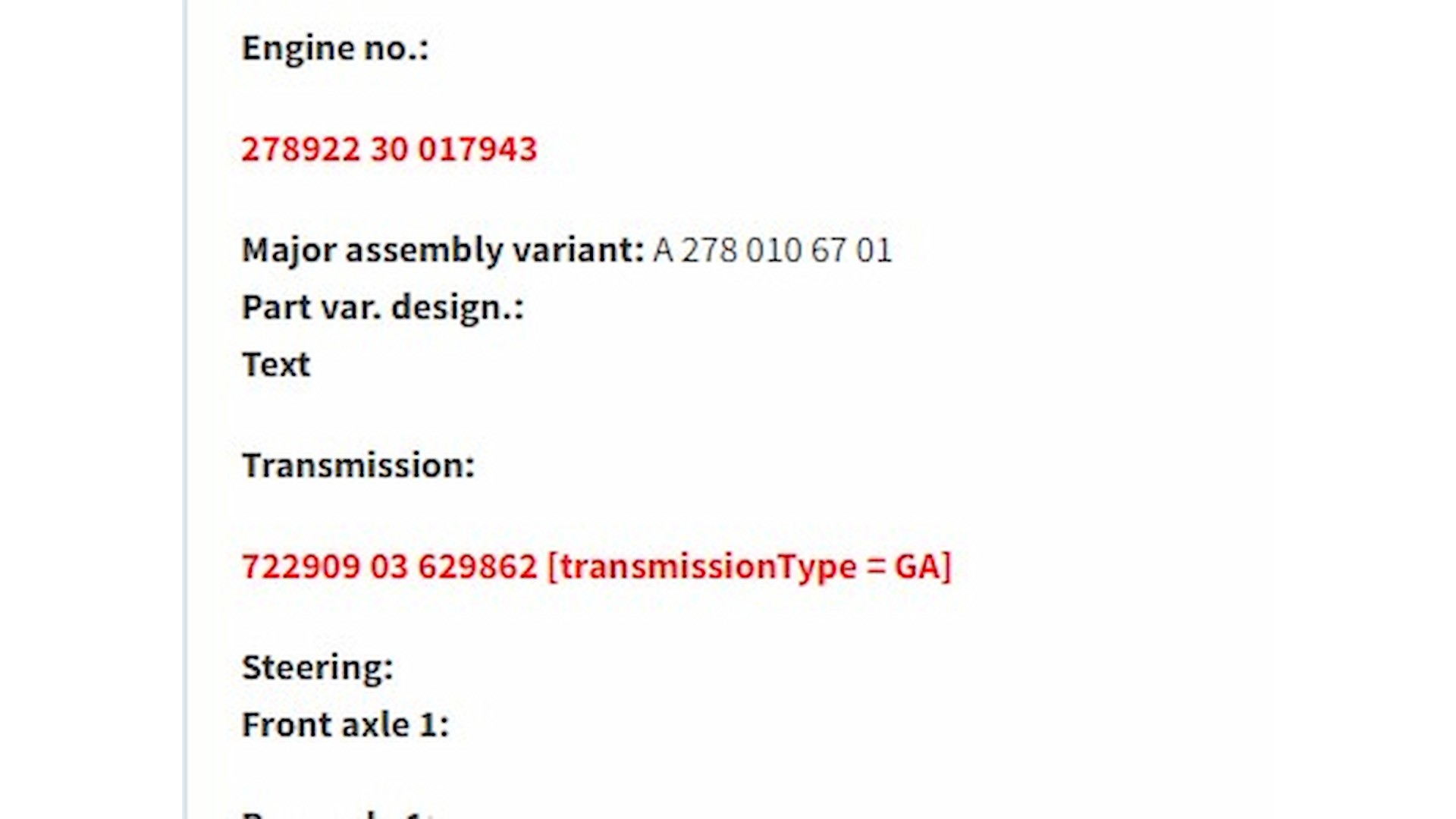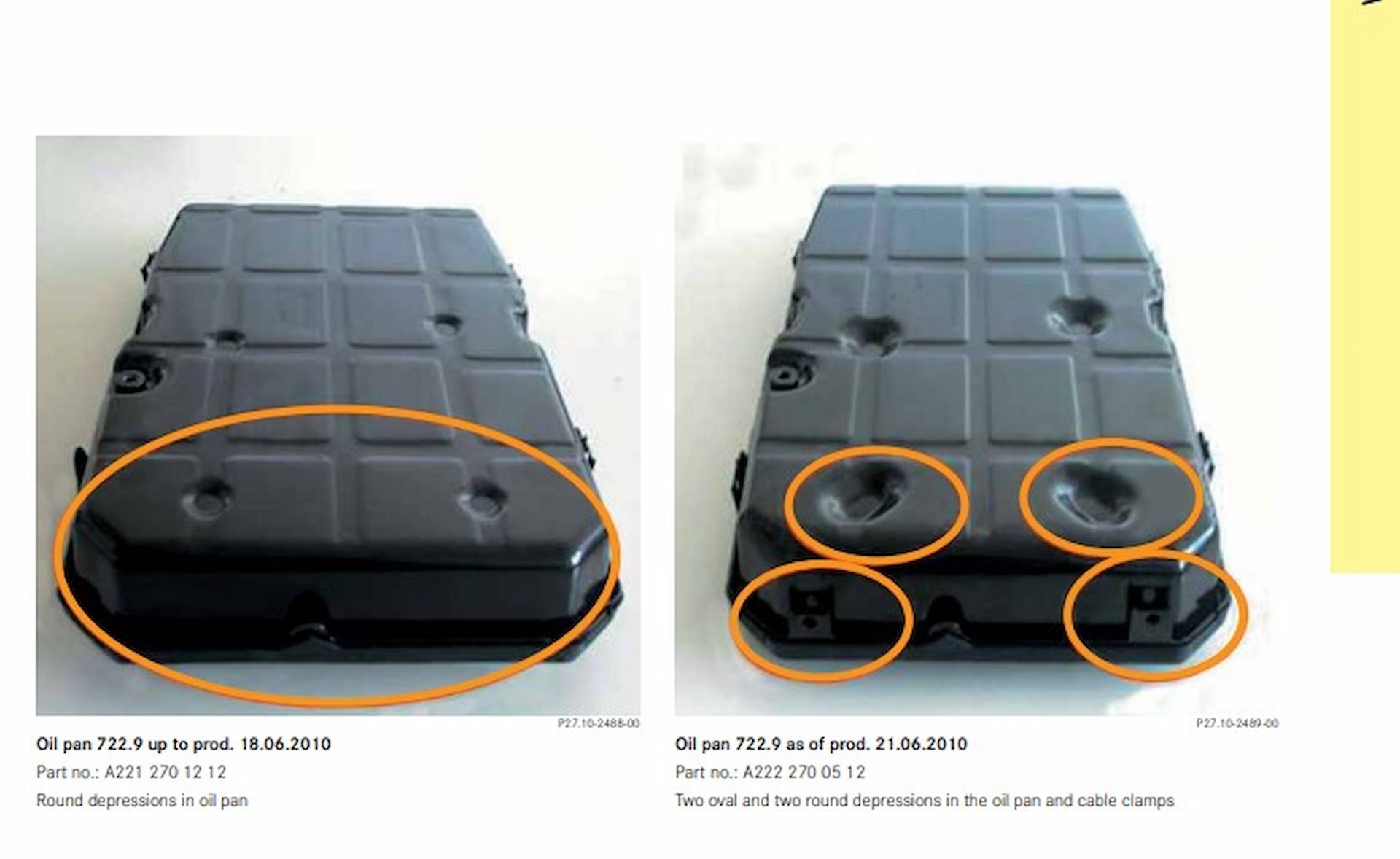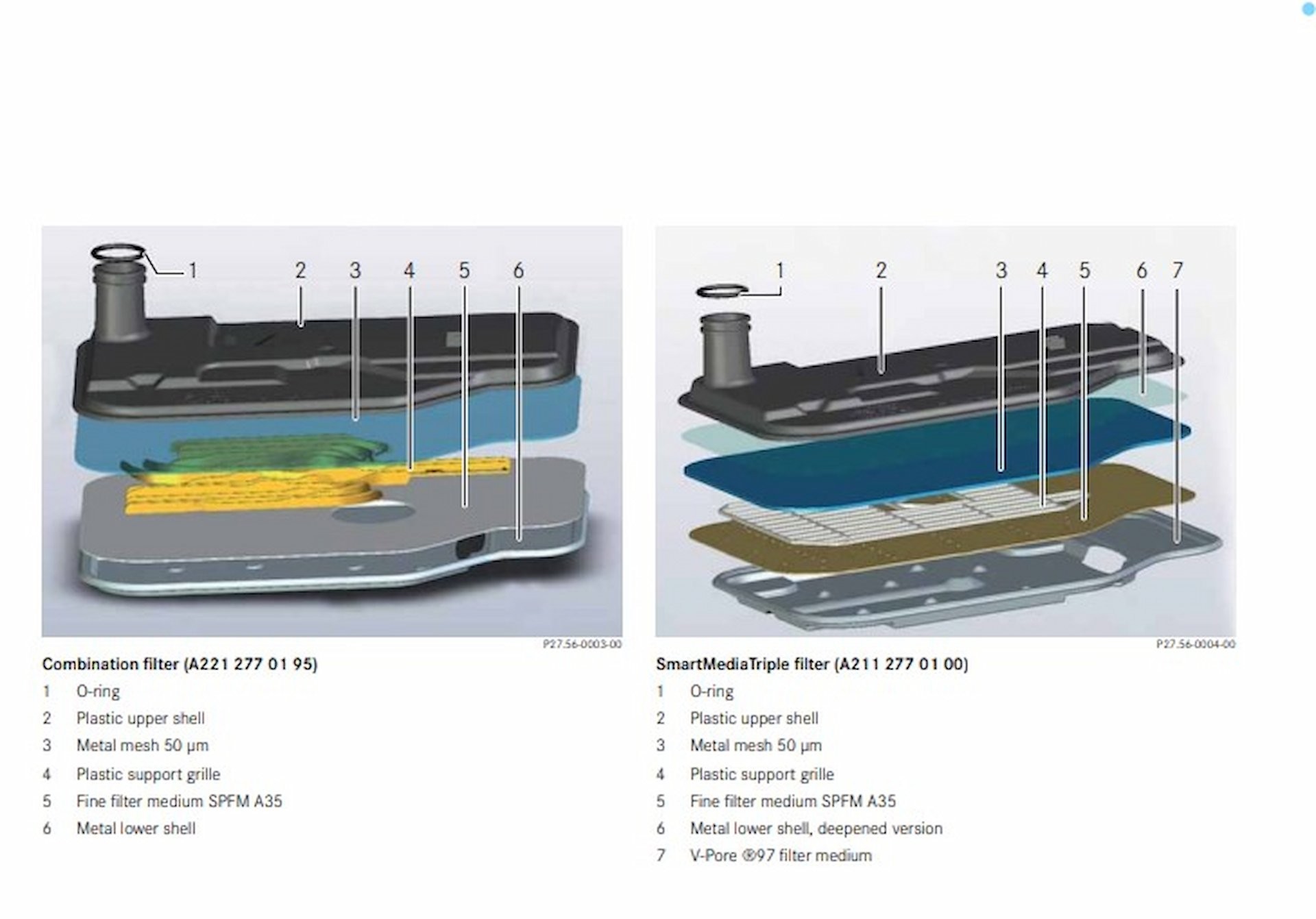Determining the correct automatic transmission fluid (ATF) for your Mercedes 722.9 (7G-Tronic) transmission is crucial for its optimal performance and longevity, and DTS-MONACO.EDU.VN is here to guide you. Using the wrong fluid can lead to serious damage. In this comprehensive guide, we’ll walk you through the different types of ATF, how to identify the correct one for your specific transmission model, and offer expert tips for maintaining your Mercedes-Benz transmission. Explore fluid compatibility, transmission service, and car coding insights to optimize your vehicle’s performance.
Contents
- 1. Understanding Mercedes 722.9 (7G-Tronic) Transmission Variants
- 2. Key Differences Between Early and Late 722.9 Transmissions
- 3. How to Determine Which Fluid Your Mercedes 722.9 Transmission Needs
- 3.1. Production Date
- 3.2. VIN Decoding
- 3.3. Checking the Transmission Serial Number
- 3.4. Physical Inspection
- 4. Mercedes 722.9 Transmission Internal Determining Features
- 4.1. Check the Pan/Pan Upgrades
- 4.2. Check the Overflow Plug
- 4.3. Locate the Serial Number
- 5. Fluid Specifications and Service Intervals
- 5.1. 722.9 “Red” Service Intervals and Info
- 5.2. 722.9 Plus “Blue” Service Intervals and Info
- 6. Potential Issues Caused by Using the Wrong ATF
- 7. Steps to Take If the Incorrect Fluid Was Used
- 8. Can You Upgrade a 722.9 to Function Like a 722.9 “Plus”?
- 9. Retrofit Kit for Improved Performance
- 10. Addressing Drive Issues with Your 722.9 Transmission
- 10.1. Scan for Fault Codes
- 10.2. Check Fluid Level and Condition
- 10.3. Conductor Plate Replacement
- 11. Mercedes 722.9 Transmission: Frequently Asked Questions
- 11.1. What should I do if the incorrect fluid color is being used in my 722.9?
- 11.2. Can I upgrade my 722.9 to function like a 722.9 “Plus” so it takes the blue fluid?
- 11.3. I’m having drive issues with my 722.9. Where should I start?
- 11.4. What are the main differences between the red and blue ATF for the 722.9 transmission?
- 11.5. Can I mix red and blue ATF in my 722.9 transmission?
- 11.6. How often should I check the ATF level in my 722.9 transmission?
- 11.7. Where can I find the correct ATF for my Mercedes 722.9 transmission?
- 11.8. What is the Mercedes-Benz BeVo specification for the blue ATF?
- 11.9. Is it possible to change the transmission fluid myself, or should I take it to a professional?
- 11.10. What are the symptoms of low transmission fluid in a 722.9 transmission?
- 12. Elevate Your Automotive Expertise with DTS-MONACO.EDU.VN
- 12.1. Comprehensive Training Programs
- 12.2. Expert Guidance and Support
- 12.3. Hands-On Experience with DTS-Monaco Software
- 12.4. Stay Ahead of the Curve
- 13. Take the Next Step in Your Automotive Career
1. Understanding Mercedes 722.9 (7G-Tronic) Transmission Variants
The Mercedes 722.9 automatic transmission, also known as 7G-Tronic, has two main variants: the “early” and “late” models. The “late” model, often referred to as “Plus,” incorporates several key improvements. Identifying which variant you have is essential for selecting the correct ATF.
- Early 722.9: Uses a red-colored ATF, similar to traditional automatic transmission fluids.
- Late 722.9 (Plus): Requires a blue-colored ATF with lower viscosity designed for reduced friction.
Any Mercedes with the updated 722.9 Plus gearbox will also have the A89 option code.
2. Key Differences Between Early and Late 722.9 Transmissions
The Mercedes 722.9 “Plus” model represents a significant redesign and enhancement over the original 722.9 transmission (referred to internally as NAT2). The Plus model, sometimes known within Mercedes as NAT2FE+, boasts several hardware improvements that enhance its performance and longevity. Here’s a detailed breakdown of these key differences:
| Feature | Early 722.9 (NAT2) | Late 722.9 Plus (NAT2FE+) |
|---|---|---|
| Torque Converter | Standard | Revised with centrifugal pendulum damper |
| Auxiliary Oil Pump | No | Yes, for stop/start lubrication |
| Operating System | Standard | Optimized for “Eco” drive modes |
| Gearset Materials | Standard | Designed for reduced friction |
| Fluid Color | Red | Blue |
| Mercedes BeVo Requirement | 236.14 | 236.15 |
| Service Interval | Every ~40,000 miles | Every ~70,000 miles |
These enhancements result in quicker and smoother shifts, thanks to the upgraded hardware and software. The redesigned components, particularly those aimed at reducing friction, necessitated the use of a new fluid with different characteristics.
3. How to Determine Which Fluid Your Mercedes 722.9 Transmission Needs
There are several reliable methods to determine whether your Mercedes 722.9 transmission requires red or blue fluid. These methods range from checking the production date and VIN decoding to physically inspecting the transmission itself.
3.1. Production Date
The easiest way to identify the correct ATF is by checking the vehicle’s production date.
- Red Fluid: Generally used in models produced before June 21, 2010.
- Blue Fluid: Typically required for models produced on or after June 21, 2010, particularly 2012 model year and later in the United States.
2011 model-year vehicles may be fringe cases and will need to be checked by their producing date or VIN to determine which they fall into.
3.2. VIN Decoding
A VIN (Vehicle Identification Number) decoder provides definitive information about your vehicle’s specifications, including the correct ATF type.
- Locate VIN Decoder: Use a reliable online VIN decoder.
- Enter VIN: Input your vehicle’s VIN into the decoder.
- Check Options Package: Look for the A89 option code. If present, your vehicle requires blue fluid.
 FCP_Euro_Mercedes_722.9_Transmission_Fluid Guide_
FCP_Euro_Mercedes_722.9_Transmission_Fluid Guide_
You can also find the transmission model number and serial at the top of the VIN Decoder page.
- Engine model and serial highlighted in the first red-text line.
- Transmission info is presented in the second red-text line.
3.3. Checking the Transmission Serial Number
Compare the serial number against official Mercedes documentation to confirm the fluid type. The serial number of the 722.9 at hand is well after the A89 changeover serial of “2834527,” and therefore, it is reaffirmed that this vehicle would require late-model fluid.
3.4. Physical Inspection
Physically inspecting the transmission can provide additional clues.
- Transmission Pan: The 722.9 “Plus” models typically have deeper dimples and additional clips on the transmission pan. They also appear deeper to accommodate the “SmartMedia” Triple filter.
- Overflow Plug: A green overflow pipe indicates the 722.9 “Plus” SmartMedia filter and deeper pan, while a white overflow pipe is used in earlier models.
4. Mercedes 722.9 Transmission Internal Determining Features
Sometimes, the most reliable way to determine the correct fluid is by visually inspecting the transmission unit. While this method might be slightly subjective, especially if you’re not the original owner, it generally provides a clear indication of the fluid type required.
4.1. Check the Pan/Pan Upgrades
The 722.9 and 722.9 “Plus” transmissions use different styles of transmission pans, primarily due to the use of different filters. This difference in pan design can help you identify the correct fluid type.
 FCP_Euro_Mercedes_722.9_Transmission_Fluid Guide_Oil_Pan_Differences
FCP_Euro_Mercedes_722.9_Transmission_Fluid Guide_Oil_Pan_Differences
As seen in the image, the 722.9 “Plus” models have deeper dimples and additional clips on the pan. The rightmost pan appears deeper than the early 722.9 pan to accommodate the “SmartMedia” Triple filter. The deeper pan allows for a greater fluid capacity and more certain lubrication.
4.2. Check the Overflow Plug
The overflow plug color also differs between the 722.9 and 722.9 “Plus” models. A green overflow pipe is a hallmark of the 722.9 “Plus” SmartMedia filter and deeper pan, while traditional earlier 722.9 models use a white overflow pipe.
One should be cautious when using these methods to gather which fluid is needed for their 722.9, though. Of course, if the car is bought secondhand, a previous owner may have completed a retrofit or upgrade similar to the one mentioned above; similarly, while many DIYers base the fluid needed for their transmission upon whichever color comes out of the unit when they remove the drain plug, the unit could very possibly have been filled incorrectly by whoever touched the unit last. In either instance, using the practices above could lead you to purchase and potentially install the incorrect fluid.
4.3. Locate the Serial Number
The safest physical method to determine the fluid required by your 722.9 is to find the transmission-specific code stamped into the unit itself and compare it against the inflection point Mercedes used between red and blue fluid models. This will require the information presented underneath the VIN Decoder section above, but rather than decoding the unit online, we would simply compare the Mercedes-specified serials to the transmission’s serial.
 FCP Euro 722.9 Transmission Guide Serial Numbers
FCP Euro 722.9 Transmission Guide Serial Numbers
The leftmost picture indicates the transmission’s serial stamping, which will face downwards and will be between the bell housing and transmission pan on all 722.9 models. On the stamp seen in the right photo, we have three distinct lines noted:
- Line 1 is the part number of the overall assembly, as the transmission corresponds to the model and engine at hand (not entirely relevant to us in this service).
- Line 2 is the model of the transmission and its variant. The model in the photo would be a 722.9 transmission and, by variant, a 722.902. This information may be good to know for a service but isn’t all that helpful in determining which fluid is needed.
- Line 3 notes the serial number of this transmission. In the case of this photo, we see “1822427.”
As blue-fluid 722.9 “Plus” models extend from serial “2834527” and beyond, and the vehicle at hand is “1822427,” our example vehicle can conclusively receive red fluid for its service.
5. Fluid Specifications and Service Intervals
Using the correct ATF is critical to maintaining the performance and longevity of your Mercedes 722.9 transmission. Here are the recommended fluid specifications and service intervals for both early and late models:
5.1. 722.9 “Red” Service Intervals and Info
- Mercedes BeVo Requirement: 236.14
- Service Interval: Every ~40,000 miles
5.2. 722.9 Plus “Blue” Service Intervals and Info
- Mercedes BeVo Requirement: 236.15
- Service Interval: Every ~70,000 miles
These service intervals are crucial for preventing wear and ensuring smooth operation. Regular maintenance helps avoid costly repairs and keeps your transmission in top condition.
6. Potential Issues Caused by Using the Wrong ATF
Using the incorrect ATF in your Mercedes 722.9 transmission can lead to a range of problems due to the specific tolerances and requirements of these gearboxes. The viscosity difference between red and blue fluids means that using the wrong one can compromise performance and cause damage. Here are some potential issues:
- Reduced Performance: Incorrect fluid can cause sluggish or erratic shifting.
- Increased Wear: Incompatible fluids may not provide adequate lubrication, leading to premature wear of internal components.
- Transmission Damage: Over time, using the wrong fluid can result in significant damage, requiring costly repairs or complete transmission replacement.
If you suspect that the wrong fluid has been used, it’s essential to take immediate action.
7. Steps to Take If the Incorrect Fluid Was Used
If you discover that the wrong ATF has been used in your Mercedes 722.9 transmission, follow these steps to mitigate potential damage:
- Immediate Action: Stop driving the vehicle as soon as possible to prevent further damage.
- Drain and Flush: Perform a complete drain and flush of the transmission system. This involves removing the incorrect fluid and cleaning the system to eliminate any residue.
- Refill with Correct Fluid: Refill the transmission with the appropriate ATF according to your transmission model (red or blue).
- Monitor Performance: After the fluid change, monitor the transmission’s performance closely. Watch for any unusual behavior, such as slipping, rough shifting, or unusual noises.
- Professional Inspection: Consider having a professional mechanic inspect the transmission to ensure no lasting damage has occurred.
By taking these steps, you can minimize the risk of long-term damage and maintain the health of your transmission.
8. Can You Upgrade a 722.9 to Function Like a 722.9 “Plus”?
Upgrading your early 722.9 transmission to function exactly like a 722.9 “Plus” model, which uses blue fluid, is not a straightforward process. It involves significant modifications that might not be practical for most owners. However, you can retrofit certain parts from the Plus transmissions to improve the reliability and longevity of your red-fluid transmission.
9. Retrofit Kit for Improved Performance
A retrofit kit is available that allows you to upgrade specific components of your early 722.9 transmission. This kit typically includes:
- SmartMedia Triple Filter: This filter offers enhanced filtration capabilities compared to the standard filter.
- Deeper Transmission Pan: The deeper pan increases fluid capacity, providing better lubrication and cooling.
- Required Overflow Plug: The correct overflow plug is designed for use with the SmartMedia filter and deeper pan.
Important Note: While these components can enhance your transmission’s performance, they do not convert it to a blue-fluid system. The early transmissions will still require red fluid even after the upgrade.
 FCP_Euro_Mercedes_722.9_Transmission_Fluid Guide_Smartmedia_Filter
FCP_Euro_Mercedes_722.9_Transmission_Fluid Guide_Smartmedia_Filter
10. Addressing Drive Issues with Your 722.9 Transmission
Experiencing drive issues with your Mercedes 722.9 transmission can be concerning, but a systematic approach to diagnosis can help pinpoint the problem.
10.1. Scan for Fault Codes
The first step in diagnosing any transmission issue is to scan for fault codes using an OBDII scanner. These codes can provide valuable information about the nature and location of the problem. Refer to a comprehensive guide on 722.9 transmission fault codes for more detailed information.
10.2. Check Fluid Level and Condition
Regardless of fault codes, always check the transmission fluid level and condition. Ensure that the fluid is at the appropriate level and that it appears clean. Contaminated or low fluid can cause a variety of transmission problems.
10.3. Conductor Plate Replacement
For some AMG models, replacing the conductor plate may not always be possible. 722.907 models use a torque converter and may have a conductor plate, but other AMG vehicles use a wet-clutch system and require a full valve body replacement.
11. Mercedes 722.9 Transmission: Frequently Asked Questions
Here are some frequently asked questions about the Mercedes 722.9 transmission and its fluid requirements:
11.1. What should I do if the incorrect fluid color is being used in my 722.9?
These gearboxes are built to specific tolerances for maximum performance and reliability. Because of the difference in viscosity between the red and fluids, using the wrong fluid will cause some kind of damage. We recommend performing a drain and flush immediately if the incorrect fluid was used.
11.2. Can I upgrade my 722.9 to function like a 722.9 “Plus” so it takes the blue fluid?
Not easily. You can, however, retrofit some parts from the Plus transmissions to improve the reliability and longevity of your red-fluid transmission.
11.3. I’m having drive issues with my 722.9. Where should I start?
Just as you would with an engine-related fault code, step one for transmission diagnosis will always be to scan for any fault codes with an OBDII scanner. Regardless of fault code, though, a wise choice is always to check that your 722.9 has the appropriate amount of fluid and that the fluid is clean. It should also be noted that for AMG models, a replacement of the conductor plate isn’t always possible; 722.907 models use a torque converter and can have a conductor plate, but the other AMG vehicles will use a wet-clutch system and will need a full valve body replacement.
11.4. What are the main differences between the red and blue ATF for the 722.9 transmission?
The main difference lies in their viscosity. The blue fluid has a lower viscosity, designed for the reduced friction components in the 722.9 Plus models.
11.5. Can I mix red and blue ATF in my 722.9 transmission?
No, mixing red and blue ATF is not recommended as they have different properties and are not compatible. Always use the fluid specified for your transmission model.
11.6. How often should I check the ATF level in my 722.9 transmission?
It’s a good practice to check the ATF level during your regular maintenance intervals, typically every 40,000 to 70,000 miles, depending on the fluid type.
11.7. Where can I find the correct ATF for my Mercedes 722.9 transmission?
You can purchase the correct ATF from reputable auto parts stores, Mercedes-Benz dealerships, or online retailers specializing in automotive fluids.
11.8. What is the Mercedes-Benz BeVo specification for the blue ATF?
The Mercedes-Benz BeVo specification for the blue ATF is 236.15.
11.9. Is it possible to change the transmission fluid myself, or should I take it to a professional?
While it is possible to change the transmission fluid yourself, it’s recommended to have it done by a professional technician to ensure the process is completed correctly and to avoid any potential damage to the transmission.
11.10. What are the symptoms of low transmission fluid in a 722.9 transmission?
Symptoms of low transmission fluid can include slipping gears, rough shifting, delayed engagement, and unusual noises from the transmission.
12. Elevate Your Automotive Expertise with DTS-MONACO.EDU.VN
At DTS-MONACO.EDU.VN, we understand the challenges faced by automotive technicians in today’s rapidly evolving industry. That’s why we offer a comprehensive range of resources to enhance your skills and knowledge, particularly in car coding and advanced diagnostics.
12.1. Comprehensive Training Programs
Our training programs are designed to provide in-depth knowledge and practical skills in car coding, diagnostics, and advanced automotive technologies. Whether you’re a novice technician or an experienced professional, our courses cater to all skill levels.
12.2. Expert Guidance and Support
Benefit from the expertise of our seasoned instructors, who bring years of industry experience to the classroom. We provide personalized guidance and support to ensure you grasp the concepts and techniques effectively.
12.3. Hands-On Experience with DTS-Monaco Software
Gain hands-on experience with the powerful DTS-Monaco software, a leading tool for car coding and diagnostics. Learn how to unlock the full potential of this software to perform advanced functions and enhance vehicle performance.
12.4. Stay Ahead of the Curve
Stay updated with the latest advancements in automotive technology through our regularly updated resources and training materials. We keep you informed about new car models, diagnostic techniques, and coding procedures.
13. Take the Next Step in Your Automotive Career
Don’t let the complexities of modern automotive technology hold you back. With DTS-MONACO.EDU.VN, you can unlock new opportunities and elevate your career to the next level.
Visit our website at DTS-MONACO.EDU.VN or contact us at Whatsapp: +1 (641) 206-8880 to learn more about our training programs and how we can help you achieve your professional goals. Located at 275 N Harrison St, Chandler, AZ 85225, United States, we are here to support your journey to becoming a car coding expert.
